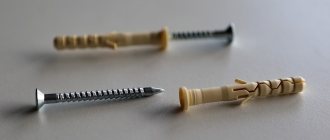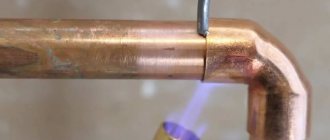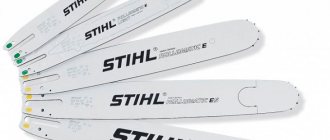What are dowels for?
On the market you can find dozens of types of fasteners, which differ in size, materials, and scope of application. The most popular dowels are: universal dowels, expansion dowels, spiral dowels, frame dowels, insulating dowels, heavy-duty dowels, nail dowels and others. Each of them is designed for specific purposes and has its own advantages and disadvantages. Let's look at the key differences and come to a conclusion in what situations certain types of fasteners are used.
Traditionally, all dowels are divided into three categories: standard, for hollow walls and special. Each of them has subgroups of hardware.
Standard dowels include:
- Expansion anchor. This is the most popular type of standard expansion dowel. Despite the fact that it is classified as standard, an expansion anchor is used extremely rarely. Its design is too light, so it is difficult for the fasteners to stay in the wall. As for loads, it is not able to withstand large and heavy objects. The name of the expansion anchor is related to the technology used to screw in the dowels: the raised part of the dowels is extended in the shape of an umbrella, providing a reliable fixation. Thanks to this principle, expansion anchors are suitable for permanent fastening in concrete and solid stone.
- General purpose dowel nails. These are universal dowel-nails that have replaced less convenient expansion fasteners. Universal dowels are one of the most popular types on the market. Thanks to the variety of shapes, they are suitable for all installations without heavy loads. They can easily be used to secure household items, such as hooks, light shelves, and decorative items. They are found in almost all types of bases, including concrete, brick - solid or hollow, wood, chipboard, light finishes. Do not use universal dowel-nails for foam concrete and insulating materials. This is the best option for solving small household problems.
Dowels for hollow bases:
- Dowels for metal cavity. This is an alternative to universal dowels. Their main value is that they can withstand heavy loads. If you need to install a TV, cabinet or any other items, use a metal cavity dowel. These dowels are suitable for all plasterboard or chipboard surfaces on walls and ceilings.
- Hinged spring dowel-nail. Its design includes a hook for securing heavy objects or for assembling complex structures. Despite the specific use of fasteners, they are quite in demand.
Special dowels:
- Insulating dowels. Most often used for mounting on facades.
- Foam concrete dowels. Special purpose for working with foam concrete. You will not be able to select other fasteners for this material, guaranteeing a reliable connection.
- Frame dowels. Thanks to the long shaft, frame dowels provide reliable fixation of heavy structures even on thick walls. They are an ideal choice for through-hole installation.
- Spiral dowels. They are a combination of two types of anchors - for hollow walls and anchors for insulating material. The name comes from the characteristic spiral threads that provide a secure hold in drywall and insulation material.
- Dowel-nails. These dowels are suitable for particularly fast mounting of parts or building frames on a wall, ceiling or floor. Mainly used when assembling light walls.
- High strength dowels. Designed to solve complex problems, for example, assembling stairs and railings.
How to install a dowel-nail in a brick or concrete base?
The dowel-nail is used for installation in brick and concrete surfaces. To do this, you need to prepare a hole of a suitable diameter in advance. To install the dowel, use the following instructions:
- Use a drill to drill a hole. The tool must be kept perpendicular to the surface, avoiding violation of the angle of inclination. The work is performed at low speeds for the first time. Once 15mm has been drilled, you can increase the speed;
- the drill is installed in the center of the designated hole;
- the resulting hole is cleaned of dust and particles of material;
- the dowel is driven in with gentle hammer blows;
- The hammer can be replaced with a screwdriver or screwdriver.
For a concrete base, follow the following instructions:
- We mark the hole using a center punch, which we hammer in;
- drill a hole. It should be longer than the dowel itself;
- we remove garbage;
- hammer in the dowel;
- We do not hammer the nail itself completely, leaving up to 4 mm for hanging.
The use of dowel fastenings when working with brickwork and concrete
To install fasteners into brick, you need to do the following:
- Choose a suitable location for the fastening material (most often this is the central part of the brick).
- Take an impact drill and start drilling. This must be done with care in order to avoid the appearance of cracks and chips on the brick. After approximately 1 cm of masonry has been drilled, the drilling speed can be increased.
- Use a vacuum cleaner to blow out small brick chips from the hole and drive in the fasteners.
To install fasteners in concrete, you must follow the following recommendations:
- Mark the hole using a hammer and punch.
- Punch a hole of the required depth using a hammer drill. The brand of the drill must match the brand of the fastener. In addition, the length of the dowel must be 5 - 6 mm less than the depth of the hole being drilled.
- Remove any dust with a vacuum cleaner and deepen the dowel using a hammer.
- All that's left is to hammer in the nail. It is recommended not to hammer it in completely. Leave 2 - 3 mm from the cap free for hanging.
How to install dowel nails in drywall and ceramics: photo instructions
When working with a plasterboard base, you must avoid attaching heavy objects. Oversized products should not be fixed, since the drywall itself is loose in texture and cannot withstand heavy loads. Such experiments will result in the resolution of the foundation.
For installation in drywall, the algorithm is practically no different from the standard sequence. The hole must be made without impact force. A drill is best for this. At the end we screw in the hardware itself with a screwdriver or screwdriver.
If you need to make a fastening joint in tile, follow the tips when working with concrete or brick. Be sure to consider the fragility of the tiles. The material is prone to splitting. To mark the location of the hole, it is better to use a center punch or a metal screw. Do everything carefully until you create a small indentation of 0.5 mm. Drill the first 15 mm at low speeds, then you can move to higher speeds. The depth of the hole is 1 cm more than the dowel itself.
What does a dowel-nail look like?
By design, this is a fairly simple fastener. Visually, the dowel-nail resembles a cylindrical rod. When installing a dowel, the hole expands. Due to this, it is possible to achieve the most tight connection.
The dowel-nails are provided with cuffs. This part of the fastener plays the role of a supporting part, which prevents the dowels from sinking. There are dowels on sale with many cuff options.
In simple words, this fastener consists of a nail and a dowel into which it is screwed. The hardware itself is often steel, the dowel is polyethylene, polypropylene or polyamide. To protect against corrosion, hardware is galvanized. There are models without zinc coating, but they are used only for internal purposes.
general description
Drywall is widely used as a leveling material to create structures with various geometries. However, the material has a significant drawback - fragility. It is justified by the low strength of the gypsum core in conditions of damaged cardboard reinforcement. Because of this, difficulties may arise with fastening or hanging certain objects, equipment, and household appliances on thin sheets.
Traditional self-tapping screws are not suitable here due to the small contact area of the rod with gypsum board. Under load, it easily pushes through cardboard and plaster. The same happens when using long hardware, which will be additionally immersed in the rough base. The situation can be changed using special fasteners. Its action is aimed at compacting the area with the hole and increasing the contact area of the fastener relative to the core or reinforcing shell.
Regular dowel-nail Source zabor.bz
Dowel-nail: how to work with fasteners?
We have already figured out that the dowel-nail consists of two parts, which play their role in creating a strong connection. The dowel-nail is suitable for fixing in concrete, brick, stone. Special dowels are made for plasterboard or wood.
If the models have a cuff, the fasteners cannot turn or get stuck in the hole. The configuration of the cuffs also varies. For use in the industrial industry, you can find special designs of dowel-nails that have a thread and a slot. They are located on the head of the product. This is convenient for screwing in with a screwdriver.
There are two ways to work with a dowel-nail:
- Manual. Hand tools are used to create the hole. This could be a screwdriver or a hammer.
- Auto. In this case, automatic tools are used. This option takes less time, but requires certain equipment.
Technical features of the dowel-nail
Technical features of dowel fasteners are determined by GOST standards. These are general requirements for the technical parameters of fasteners. GOST specifies not only technical standards, but also permissible deviations. All manufacturers who intend to sell products and enter the market must comply with these requirements and have quality certificates after assessing the fasteners.
Otherwise, the reliability of the connection cannot be guaranteed and large-scale projects requiring high quality fastening connections cannot be implemented. GOST indicates permissible changes in configuration, length, weight, diameter and other indicators. Taking into account these deviations, uniform standards must be observed for each hardware manufacturer. Let's consider the basic requirements for the production of dowel-nails:
- Fasteners are made of steel. This material can withstand heavy loads. The hardness of the metal is determined according to the Rockwell scale and must be at least 54 HRC.
- The rod may not be perfectly straight, as slight curvature is allowed. Its value is determined depending on the diameter of the hardware. If the diameter is less than 50 mm, then a deviation of up to 0.1 mm is acceptable. For a dowel-nail measuring more than 5 cm, the curvature does not exceed 0.15 mm.
- The dowel-nail design has a pointed tip. Slight dullness is expected. It can be within 0.8 mm, but not exceed this value. The tip of the dowel should be smooth, without defects, with a smooth transition into the rod. There should be no gaps or other deformations on the surface.
- The nail itself may have traces of clamps on the work surface. This is acceptable when processing hardware.
- In models with grooved edges, the pitch between them is no more than 0.8 mm. The maximum permissible depth between faces is set.
- If you disassemble the structure of dowels with washers, the shear force is at least 0.3 kN.
- If you are using a galvanized product, the coating of which protects the hardware from corrosion, determine the minimum thickness of the coating. The zinc layer must be at least 6 microns. Otherwise, there will be practically no benefit from such coverage. To finish fasteners, the cathodic method is used.
There are other quality criteria that apply to specific dowel-nail models.
Weight and dimensions
Products are produced in very different sizes, given how different the purpose may be. The parameters are marked with 2 numbers: the first indicates the diameter, the second indicates the length in mm.
- The parameters vary from 5*23 to 10*160. The load that the product can withstand must be indicated.
- The weight of the product for different sizes and materials, of course, is different, but since the fastener itself is still small, the weight is indicated not as 1, but as 1000 nails.
As an example, the table shows dimensional data for a dowel-nail with a polypropylene spacer body.
| Designation | Hole diameter, mm | Nail diameter, mm | Dowel length, mm | Nail length, mm | Min. depth for through installation | Max. thickness of attached material | Weight 1000 shi, kg |
| 6*40 | 6.00 | 40 | 4 | 42 | 50 | 10 | 3,3 |
| 6*60 | 6.00 | 60 | 4 | 62 | 70 | 30 | 4,89 |
| 6*80 | 6 | 80 | 4 | 82 | 90 | 50 | 7,28 |
| 8*60 | 8 | 60 | 5 | 62 | 70 | 20 | 8,5 |
| 8*80 | 8 | 80 | 5 | 82 | 90 | 40 | 11,02 |
| 8*100 | 8 | 100 | 5 | 102 | 110 | 60 | 13,78 |
| 8*120 | 8 | 120 | 5 | 122 | 130 | 80 | 16,53 |
| 8*140 | 8 | 140 | 5 | 142 | 115 | 100 | 19,3 |
| 10*100 | 10 | 100 | 7 | 102 | 150 | 50 | 15,32 |
The dimensions and weight of the product for a construction and assembly gun vary within smaller limits.
| Designation | Weight 1000 pcs, kg |
| 4,5*30 | 5,1 |
| 4,5*40 | 6,45 |
| 4,5*50 | 7,7 |
| 4,5*60 | 8,84 |
Next, the technical characteristics of dowel-nails will be considered.
Methods for installing dowel-nails: photo
Another popular classification of fasteners is by installation method. The following options are available:
- by hammering. This method is suitable for fasteners with smooth threads. If the hardware does not have edges for a screwdriver, then you will have to carefully drive it into the surface. A dowel-nail with a thread is more convenient because the risk of damage to the surface is reduced, and if necessary, it can be easily dismantled. Without threads, getting fasteners is problematic and sometimes impossible;
- mounting gun. If the configuration of the hardware provides for the presence of a cuff, it can be mounted with a construction and assembly gun. This method is quite common, since it provides that the fasteners can withstand heavy loads.
There are dozens of dowel nails for certain types of surfaces. Let's look at their features:
- For porous concrete. Such fasteners are made with grooved ribs that fit easily and tightly to the dowel when driven in. For installation, be sure to make a pilot hole.
- For surfaces with voids. Such fasteners are made elongated so that they can be tightly fixed to the base. Strong adhesion is ensured by the presence of special jumpers.
- For lathing. If the sheathing is located a short distance from the wall, it can also be fixed. A distance of up to 30 mm is acceptable. One part of the dowel secures the structure of the slats, the second - the wall. The dowels are mounted with a screw.
- Universal mount. Such hardware adapts to the characteristics of the surface. For example, when working with hard and homogeneous material, the body expands when driven in. For hollow structures, the dowel-nail behaves differently - it is as close to the base as possible.
- For thin walls. Metal fasteners are most suitable. When fixed, the hardware firmly adheres to the bases with a small thickness, preventing deformation.
- For suspended ceilings. In this case, special fasteners are used. You can find them on sale under the name “butterfly”. This fastener is designed for materials with voids. The dowel-nails have a spring mechanism that opens when the hardware is driven in. Structurally, this fastener has hooks and threads for quick and reliable connection.
- For massive and large hanging products. Due to their heavy weight, such dowel-nails are used for mounting into concrete or brick surfaces. For example, you need to secure a gate or door. Multi-ton loads with fasteners of this type are acceptable.
- For gas or foam concrete. Manufacturers produce metal and plastic fasteners. The tip in such models has the shape of a drill, and there is a thread on the rod. The main advantage of such products is that you do not have to make a hole for them. Using special models, you spend less time creating fastening joints.
- For thermal insulation. The fastener locks into place without a nail or pre-pilot hole.
- For bricks with voids. Installed using adhesive. This is a rather labor-intensive process that must be justified.
Dowel fastener. Types of products
These products are divided into categories according to:
fastening method
The design features, as well as the base material, are taken into account. If the base is of high density, which causes certain difficulties in the process of fastening various elements, you should use dowels for brick or concrete
To work with such surfaces, you can choose: Expansion dowel. Depending on the manufacturer, the product may differ in shape, as well as in the number of teeth, ailerons, and spikes. Universal fastener. In solid materials it manifests itself in the same way as the spacer type, but in hollow materials it shows different qualities. Facade dowel and frame. The products are designed for fastening into dense bases, even if they are classified as slotted. Nail type. Designed for mass quick installation. Most often requires the use of a mounting gun. If the work will be carried out with loose or hollow materials, then in these cases it is better to choose a universal option, frame (can be used when installed in a foam concrete base during the installation of plastic door and window structures), driven (for aerated concrete), as well as screw-on, panel and sheet dowel.
type of installation
In this case, it is not the method of immersing nails into dowels that is taken into account, but the installation of the dowel itself. Today there are two methods: Pre-installation
The fasteners are fixed into the base. The attached element fits as tightly as possible to the “body”. The largest percentage of types of dowels work exactly according to the mentioned principle (universal, nail, spacer). Through installation. Before fastening into the base, the fastener must pass through a void area or a certain layer of intermediate material. To carry out this process, a product with an elongated non-expanding part is used. We are talking about frame, facade, and roofing dowels. In addition, there are models of fasteners for insulation. They can be either spacer or non-spacer. They are distinguished by the presence of a rather large cap (diameter - from 45 to 90 mm), which allows them to hold loose material, as well as soft ones.
- material. Most often, dowel fasteners are made using plastic. This is explained by the fact that the level of installation strength is determined by the ease, as well as the force of deformation. Plastic is endowed with elasticity and viscosity, which allows it to deform more easily than other materials. At the same time, the plastic does not lose its characteristics. Thus, today there are dowels made from the following materials:
- Polyethylene. The products are lightweight and resistant to acids. The raw material is endowed with excellent viscosity and is able to retain its qualities during deformation. Fastening material made of polyethylene is resistant to corrosion reactions and is not subject to cracking after long-term use. It is resistant to low temperatures (used at –40 degrees Celsius).
- Polypropylene. It has high hardness and wear resistance, but cannot be used at very low temperatures. But it performs well at high temperatures (deformation is observed at +140 °C or more).
- Nylon or polyamide. Products made from this material are endowed with a high level of rigidity and strength. They are resistant to mechanical stress and vibration processes, and are durable. A nylon dowel is recognized as a more reliable fastener, but it is not recommended to use it in frosty or humid weather.
How to choose a dowel-nail: valuable tips
Experts highlight several useful tips that will help you choose the right dowel-nail for solving specific problems. Consider the following tips:
- determine the loads that the fastener must withstand. This is the first criterion from which you need to proceed when searching for suitable hardware;
- to fasten furniture, which itself weighs quite a lot and must also withstand additional loads, you will need hardware with a diameter of at least 85 mm;
- for insulation work, fastening skirting boards, and other horizontal fixations, the dowel must be at least 3 cm long and its diameter at least 6 mm;
- When working with suspended ceilings or other products in which the load is determined from the bottom, dowels with spacer notches should be used. Due to the corrugated surface on the working surface, the necessary fixation is ensured;
- if you need to find hardware for an existing hole, correctly determine its diameter. It should be equal to the hole. Otherwise, you will not be able to ensure a secure fastening. This may cause the dowel to become loose;
- When working with foam concrete, be sure to ensure the reliability of the fastening connection. The load should be evenly distributed.
To choose the right dowel-nail, it is important to determine what type of surface you will be working with. Universal types of dowels are suitable for old concrete walls. If the service life is too long, there is a possibility of formation of seals and irregularities. In this case, universal hardware will do. Key rule: the dimensions and length of the dowel are selected according to the loads on it. If you plan to fasten large and massive objects, it is better to choose long and durable hardware of sufficient thickness.











